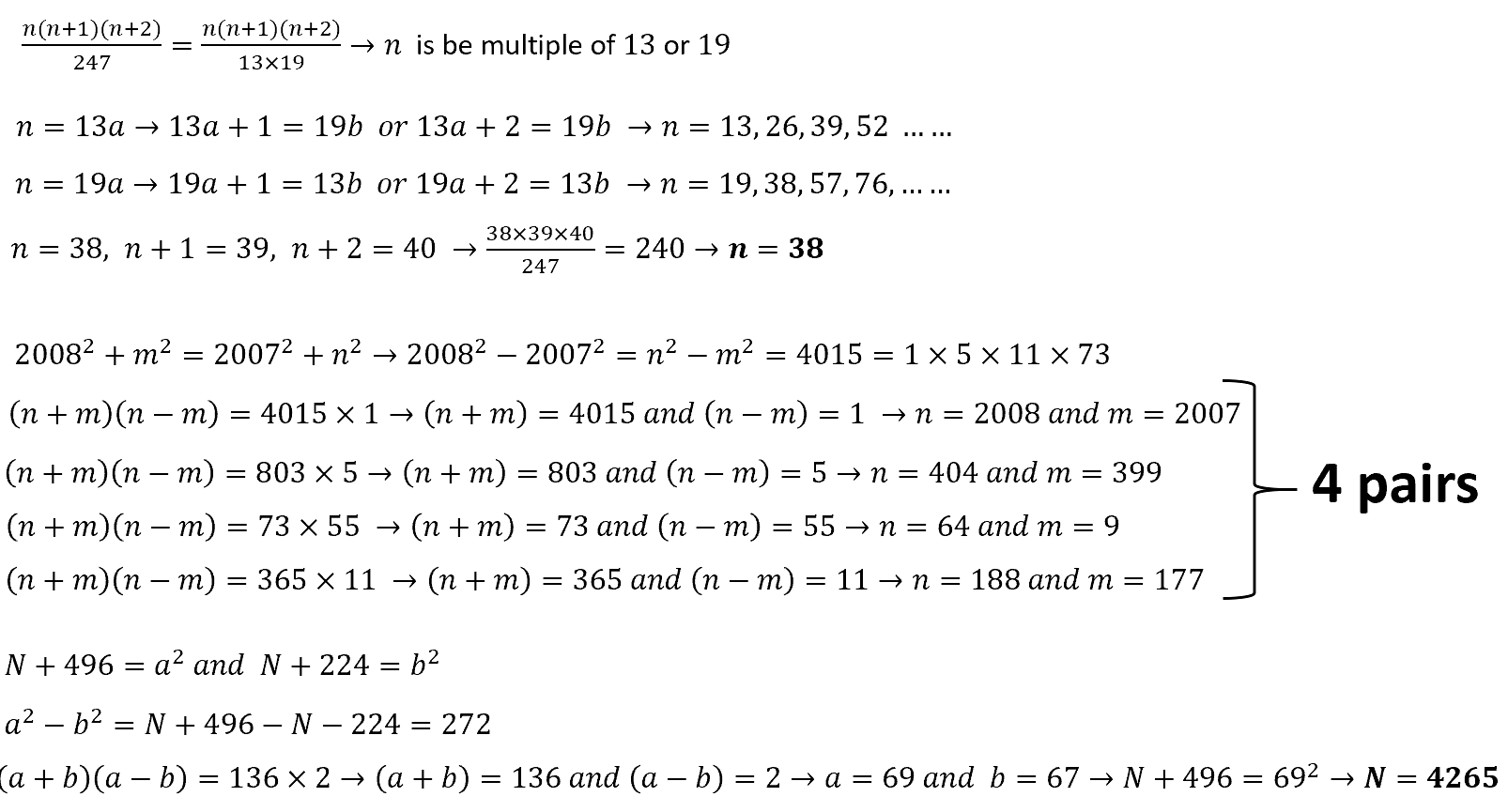Ask Singapore Homework?
Upload a photo of a Singapore homework and someone will email you the solution for free.

See 2 Answers
6. n(n+1)(n+2) is divisible by 247. Find the smallest positive integer n
Now 247 = 13 x 19. So at least 1 of the above factors should be a multiple of 13 and at least 1 should be a multiple of 19.
What we can do is to list the multiples of 13 and 19 and see if there are any multiples that are consecutive numbers or if their difference is 2.
13,26,39,52,65,78,91,104
19,38,57,76,95,114
We notice that 38 and 39 are consecutive. And 76 and 78 are 2 apart.
So we could have 76 x 77 x 78 or 3 x 39 x 40 or 37 x 38 x 39. They are all divisible by 247.
Smallest n would be 37
Now 247 = 13 x 19. So at least 1 of the above factors should be a multiple of 13 and at least 1 should be a multiple of 19.
What we can do is to list the multiples of 13 and 19 and see if there are any multiples that are consecutive numbers or if their difference is 2.
13,26,39,52,65,78,91,104
19,38,57,76,95,114
We notice that 38 and 39 are consecutive. And 76 and 78 are 2 apart.
So we could have 76 x 77 x 78 or 3 x 39 x 40 or 37 x 38 x 39. They are all divisible by 247.
Smallest n would be 37
7.
① 0 < m < n < 2008
②2008² + m² = 2007² + n²
Rearranging ②,
2008² - 2007² = n² - m²
(2008 + 2007)(2008 - 2007) = (n + m)(n - m)
4015 = (n + m)(n - m)
We can break down 4015 into its prime factors first.
4015 ÷ 5 = 803
803 ÷ 11 = 73
73 is prime it is only divisible by itself and 1.
So, 4015 = 11 x 73 x 5 and we have the 3 following possible products of 2 numbers that make up 4015 and where ① holds
1. (11 x 73) x 5 = 803 x 5
So n+m = 803 , n-m = 5.
From this we can tell that :
2m = 803 - 5 = 798
m = 399
n = 803 - 399 = 404
So we have one found one ordered pair (399,404)
2. 11 x (73 x 5) = 11 x 365
Using the above method,
the ordered pair here is (177,188)
3. (11 x 5) x 73 = 55 x 73
Likewise, the ordered pair here is (9,64)
① 0 < m < n < 2008
②2008² + m² = 2007² + n²
Rearranging ②,
2008² - 2007² = n² - m²
(2008 + 2007)(2008 - 2007) = (n + m)(n - m)
4015 = (n + m)(n - m)
We can break down 4015 into its prime factors first.
4015 ÷ 5 = 803
803 ÷ 11 = 73
73 is prime it is only divisible by itself and 1.
So, 4015 = 11 x 73 x 5 and we have the 3 following possible products of 2 numbers that make up 4015 and where ① holds
1. (11 x 73) x 5 = 803 x 5
So n+m = 803 , n-m = 5.
From this we can tell that :
2m = 803 - 5 = 798
m = 399
n = 803 - 399 = 404
So we have one found one ordered pair (399,404)
2. 11 x (73 x 5) = 11 x 365
Using the above method,
the ordered pair here is (177,188)
3. (11 x 5) x 73 = 55 x 73
Likewise, the ordered pair here is (9,64)
8. Find the largest possible N such that N + 496 and N + 224 are perfect squares.
If they are perfect squares, we use the property x² - y² = (x + y)(x - y), and let x > y
Difference of the two squares
= 496 - 224 = 272
So 272 = (x + y)(x - y)
Similar to question 7, we break the number into its prime factors.
272 ÷ 2 = 136
136 ÷ 2 = 68
68 ÷ 2 = 34
34 ÷ 2 = 17
So 272 = 17 x 2 x 2 x 2 x 2
Possible products of 2 numbers :
17 x (2 x 2 x 2 x 2) = 17 x 16
(17 x 2) x 2 x 2 x 2 = 34 x 8
(17 x 2 x 2) x 2 x 2 = 68 x 4
(17 x 2 x 2 x 2) x 2 = 136 x 2
272 x 1
These are all possible combos of (x+y)(x-y).
If we want the largest possible N then we should ensure that x+y (their sum) is as big as possible and x-y (their difference) is as small as possible.
This gives us the largest possible x² and y², which in turn gives us the largest N.
But we cannot pick 272 x 1 as that would mean :
(x+y) - (x-y) = 2y = 272 - 1 = 271
y = 135.5
x = 136.5
And these are not integers, so x² and y² are not perfect squares.
So we choose 136 x 2.
2y = 136 - 2 = 134
y = 67
x = 67 + 2 = 69
Largest possible N
= x² - 496
= 69² - 496
= 4761 - 496
= 4265
Or
Largest possible N
= y² - 224
= 67² - 224
= 4489 - 224
= 4265
If they are perfect squares, we use the property x² - y² = (x + y)(x - y), and let x > y
Difference of the two squares
= 496 - 224 = 272
So 272 = (x + y)(x - y)
Similar to question 7, we break the number into its prime factors.
272 ÷ 2 = 136
136 ÷ 2 = 68
68 ÷ 2 = 34
34 ÷ 2 = 17
So 272 = 17 x 2 x 2 x 2 x 2
Possible products of 2 numbers :
17 x (2 x 2 x 2 x 2) = 17 x 16
(17 x 2) x 2 x 2 x 2 = 34 x 8
(17 x 2 x 2) x 2 x 2 = 68 x 4
(17 x 2 x 2 x 2) x 2 = 136 x 2
272 x 1
These are all possible combos of (x+y)(x-y).
If we want the largest possible N then we should ensure that x+y (their sum) is as big as possible and x-y (their difference) is as small as possible.
This gives us the largest possible x² and y², which in turn gives us the largest N.
But we cannot pick 272 x 1 as that would mean :
(x+y) - (x-y) = 2y = 272 - 1 = 271
y = 135.5
x = 136.5
And these are not integers, so x² and y² are not perfect squares.
So we choose 136 x 2.
2y = 136 - 2 = 134
y = 67
x = 67 + 2 = 69
Largest possible N
= x² - 496
= 69² - 496
= 4761 - 496
= 4265
Or
Largest possible N
= y² - 224
= 67² - 224
= 4489 - 224
= 4265
Just a comment on my method for the 1st part. As long as either n or n+1 or n+2 is a multiple of 13 and 19 is sufficient. Hence you can choose 37 x 38 x 39 where 38 is a multiple of 19 and 39 is a multiple of 13.
For question 7, there should only be 3 ordered pairs since 0 < m < n < 2008, which means (2007,2008) doesn't satisfy the inequality






